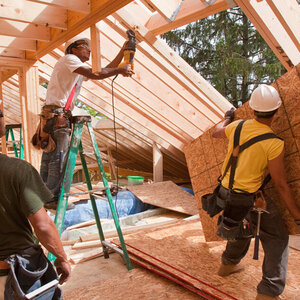Residential Real Estate News

U.S. Opportunity Zones Rebound in Q2
Residential News » Irvine Edition | By Michael Gerrity | August 17, 2023 7:28 AM ET
According to ATTOM's newly released second-quarter 2023 Opportunity Zones report, median single-family home and condo prices increased from the first quarter of 2023 to the second quarter of 2023 in 61 percent of Opportunity Zones around the U.S., and rose at least 5 percent in about half.
The increases reversed a brief fallback in values during the prior two quarters in a majority of zones, which sit in and around low-income neighborhoods where the federal government offers tax breaks to spur economic revival.
The renewed price growth continued a long-term pattern of trends in Opportunity Zones largely matching those in other neighborhoods around the U.S. Values in those areas also dipped from late 2022 into early 2023 before recovering in the second quarter. Changes in home values inside Opportunity Zones have been tracking closely with national patterns for at least the last three years - mostly rising in a sign of economic strength inside some of the country's most distressed communities.
By two key measures, Opportunity Zone markets even showed signs of rebounding slightly better than other neighborhoods around the country during the second quarter of this year. Median prices inside those zones rose more often at a faster pace than the nationwide gain both quarterly and annually.
"Another quarter and another sign of housing market strength. That was the story yet again in Opportunity Zones around the U.S. during the Spring buying season of 2023," said Rob Barber, CEO for ATTOM. "It doesn't seem to matter whether the national market is booming or cooling off. Prices are rising or falling at about the same pace inside Opportunity Zones as they are elsewhere around the U.S. - and even doing a little better in some ways. For sure, prices remain low in Opportunity Zones. But once again, home value trends present a positive note for investors considering using federal tax breaks offered to redevelop neighborhoods in need of revival."
Opportunity Zones are defined in the Tax Act legislation as census tracts in or alongside low-income neighborhoods that meet various criteria for redevelopment in all 50 states, the District of Columbia and U.S. territories. Census tracts, as defined by the U.S. Census Bureau, cover areas that have 1,200 to 8,000 residents, with an average of about 4,000 people.
As they have for many years, or even decades, typical home values in Opportunity Zones continued to fall well below those in most other neighborhoods around the nation in the second quarter of 2023. Median second-quarter prices were less than the U.S. median of $350,000 in 80 percent of Opportunity Zones analyzed. That was about the same portion as in earlier periods over the past year. In addition, median prices remained less than $200,000 in 49 percent of the zones during the second quarter of 2023.
Considerable price volatility also continued in Opportunity Zones, with median values either dropping or increasing by at least 5 percent in two-thirds of those locations from the first quarter of 2023 to the second quarter of 2023. That likely reflected the small number of sales in many zones.
Still, second-quarter trends showed that the earlier downturn in home values nationwide failed to cause a long-term slump in Opportunity Zones, despite their economic distress. That suggests that a decade of home-price run ups across the U.S. continues to leave a significant cluster of potential buyers with limited resources with no choice but to take a chance and purchase homes in the lowest-priced communities. The apparently healthy demand in the second quarter continued even as home-mortgage rates climbed back up toward 7 percent for 30-year loans this Spring, cutting into what buyers could afford.
"Opportunity Zones appear to still be enjoying the trickle-down effect of value spikes in mid-level markets that have likely priced marginal buyers out," Barber added. "With an ongoing tight supply of homes for sale pushing the trends even more throughout the country, there are no major signs that Opportunity Zones' price patterns will fall out of step with the national scenario in the near future."
High-level report findings:
- Median prices of single-family homes and condominiums increased from the first quarter of 2023 to the second quarter of 2023 in 1,977 (61 percent) of the Opportunity Zones around the U.S. with sufficient data to analyze, while decreasing or staying the same in 39 percent. Medians also were up from the second quarter of 2022 to the same period this year in 2,049 (55 percent) of those zones. (Among the 3,909 Opportunity Zones included in the report, 3,248 had enough data to generate usable median-price comparisons from the first quarter of 2023 to the second quarter of 2023; 3,704 had enough data to make comparisons between the second quarter of 2022 and the second quarter of 2023).
- Median values went up at least 5 percent quarterly in 52 percent of Opportunity Zones with sufficient data to analyze.
- But in a sign that Opportunity Zones did a bit better than the rest of the country, median prices were up year-over-year by at least 3 percent in a higher portion of those areas. They were up annually by that much in 50 percent of Opportunity Zones versus 45 percent of local markets in other parts of the country.
- Among states that had at least 25 Opportunity Zones with enough data to analyze during the second quarter of 2023, the largest portions of zones where median prices rose quarterly were in Minnesota (medians up from the first quarter of 2023 to the second quarter of 2023 in 76 percent of zones), Tennessee (75 percent), Alabama (68 percent), California (67 percent) and Indiana (67 percent). States where prices were up quarterly in the smallest portion of zones included Louisiana (median prices up quarterly in 45 percent of zones), Colorado (53 percent), Virginia (53 percent), Oregon (54 percent) and Texas (58 percent).
- States where median home values in Opportunity Zones were up most often year over year included Indiana (median prices up annually in 88 percent of zones), Massachusetts (82 percent), New Jersey (80 percent), Tennessee (80 percent) and Missouri (79 percent).
- Of the 3,909 zones in the report, 1,282 (33 percent) had median prices in the second quarter of 2023 that were less than $150,000. That was down from 36 percent of those zones a year earlier. Another 614 zones (16 percent) had medians in the second quarter of this year ranging from $150,000 to $199,999.
- Median values in the second quarter of 2023 ranged from $200,000 to $299,999 in 923 Opportunity Zones (24 percent) while they topped the nationwide second-quarter median of $350,000 in just 754 (19 percent).
- The Midwest continued in the second quarter of 2023 to have larger portions of the lowest-priced Opportunity Zone tracts.
- edian home prices were less than $175,000 in 66 percent of zones in the Midwest, followed by the Northeast (46 percent), the South (43 percent) and the West (6 percent).
- Median household incomes in 87 percent of Opportunity Zones analyzed were less than the medians in the counties where they were located. Median incomes were less than three-quarters of county-level figures in 55 percent of zones and less than half in 15 percent.
Sign Up Free | The WPJ Weekly Newsletter
Relevant real estate news.
Actionable market intelligence.
Right to your inbox every week.
Real Estate Listings Showcase
Related News Stories
Residential Real Estate Headlines
- Record High Monthly Housing Payments Put Chill in U.S. Spring Selling Season
- Manila is World's Top Housing Market for Price Appreciation in Early 2024
- U.S. Homeowner Equity Dips Again in Early 2024
- Las Vegas Home Sales Jump 19 Percent Annually in April
- U.S. Mortgage Rates Continue to Climb in Early May, Fifth Consecutive Week
- Most Popular U.S. Home Remodeling Projects Revealed
- U.S. Home Price Appreciation Accelerated in February
- Residential Rents in U.S. Decline for Eighth Consecutive Month in March
- In Today's Economy, 58 Percent of U.S. Homeowners Can't Afford to Buy Their Current Home
- U.S. Mortgage Rates Continue to Climb Above 7 Percent in Late April
- Automated Property Pricing Algorithms Bolster Price-Fixing Claims, Say DOJ
- Cost of Buying a Home Hits Record High as Mortgage Rates Jump in U.S.
- Greater Miami Residential Sales Decline 15 Percent in March
- Residential Property Sales Dip Across America in March
- Meet Samantha: Your A.I. Real Estate Agent of the Future
- U.S. Home Values Rising Fastest in Most Expensive West Coast Cities in Early 2024
- U.S. Housing Starts Dive 14.7 Percent from High Interest Rates in March
- One in Five San Francisco Home Sellers Take a Loss on Their Sale in 2024
- Most U.S. Homebuyers in the Dark About Agent Commissions
- America's March 2024 Inflation Data Is Very Bad, Says NAR Chief Economist
- 2023 Slowest Year for Las Vegas Area Home Sales Since 2008
- Average U.S. Homebuyer Down Payment Hits $56,000 in Early 2024
- Rising U.S. Mortgage Rates Further Discourage Future Homebuyers in April
- Shrinkflation Hitting U.S. Homebuilder industry as Affordability Challenges Remain
- Greater Palm Beach Area Residential Sales Downtick 2 Percent in February
- During Biden Presidency U.S. Housing Costs Grew Twice as Fast as Incomes
- U.S. Pending Home Sales Down 7 Percent Annually in February
- High Mortgage Rates in February Slow New Home Sales in America
- California Home Sales Uptick in February
- Mainland Chinese Buyers Flock Back to Hong Kong Luxury Properties in Early 2024
- Greater Miami Overall Residential Sales Uptick 1 Percent in February
- Home Sales in U.S. Down 3 Percent Annually in February
- Super Luxury Home Sales Spike 11 Percent Worldwide in Q4
- Mortgage Rates in U.S. Tick Down in Mid-March
- NAR Agrees to Landmark $418 Million Settlement, Altering Commission Payments Forever
- Majority of U.S. Voters Say Housing Affordability Affects Their Pick for President in 2024
- Want to Sell Your American Home at Max Price, List in June
- U.S. Annual Home Price Growth to Slow to 2.6 Percent by Year End 2024
- U.S. Mortgage Rates Continue to Rise for Fourth Consecutive Week
- Income Needed to Buy a Home in America Spikes 80 Percent During Biden Presidency





